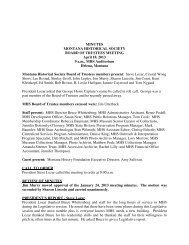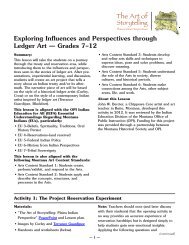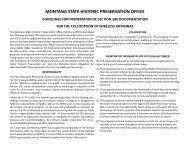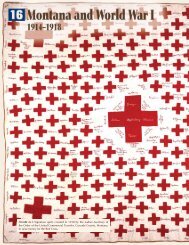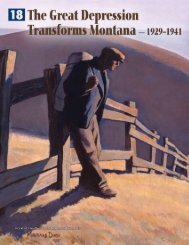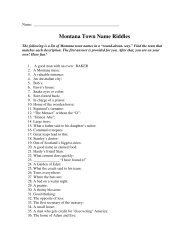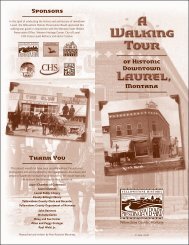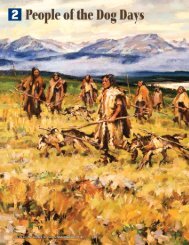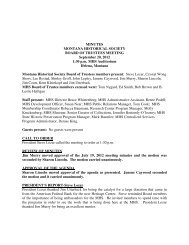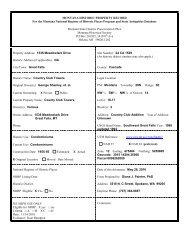Chapter 11 - Montana Historical Society
Chapter 11 - Montana Historical Society
Chapter 11 - Montana Historical Society
Create successful ePaper yourself
Turn your PDF publications into a flip-book with our unique Google optimized e-Paper software.
“<br />
Our belongings were taken from us,<br />
even the little medicine bags our mothers<br />
had given us to protect us from harm.<br />
Everything was placed in a heap and set<br />
afi re. Next was the long hair, the pride<br />
of all the Indians. The boys, one by one,<br />
would break down and cry when they<br />
saw their braids thrown on the fl oor.”<br />
—LONE WOLF, A BLACKFEET CHILD WHO WAS SENT TO<br />
CARLISLE INDIAN INDUSTRIAL SCHOOL<br />
FIGURE <strong>11</strong>.19: Girls at the Fort Shaw<br />
Indian School (a former military fort<br />
southwest of Great Falls) learned<br />
sewing, embroidery, knitting, and<br />
other household skills so they could<br />
take domestic jobs when they were<br />
fi nished with school.<br />
2 2 4 P A R T 2 : A C E N T U R Y O F T R A N S F O R M A T I O N<br />
back. Reservation schools usually allowed<br />
parents to see their children for short vacations.<br />
But students at the faraway schools<br />
were sent to white families to work during<br />
school vacations.<br />
Educated Indians Helped Their Tribes<br />
Even though boarding schools caused much<br />
pain and heartache, they also taught Indian<br />
children new skills. Educated Indians returned<br />
home with job skills and knowledge that<br />
helped them improve life on the reservations.<br />
Crow chief Plenty Coups knew how important it was for the tribe<br />
to have young, educated Indians who knew how to speak, write, and<br />
negotiate with white lawyers and politicians. As young educated men returned<br />
from off-reservation boarding schools, he put them to work making<br />
sure the government fulfi lled its treaty obligations. Some, like Robert<br />
Yellowtail, negotiated with Congress and became activist leaders.<br />
One powerful example happened in 1898. A government delegation<br />
pressured the Crow tribe to give up more land for railroads and homesteads.<br />
Plenty Coups told the delegation that the government already<br />
was behind on payments already promised. “When you have made<br />
these settlements to the Indians, then you can come back and I and my<br />
people will talk to you about these lands you now want,” he said.<br />
Then Plenty Coups introduced a group of young men just back from<br />
government schools. One of them, Carl Leider, stepped up and read an<br />
itemized list of the payments the government had promised—and failed—<br />
to make. Leider stunned<br />
the commissioners. They<br />
left, promising to postpone<br />
discussions until<br />
payments could be made.<br />
Blackfeet leader Robert<br />
Hamilton stood up for<br />
the rights of traditional<br />
full-blood Blackfeet people<br />
against a group of<br />
mixed-blood Blackfeet<br />
businessmen who wanted<br />
to control most of the<br />
tribe’s resources. The<br />
government listened to<br />
the businessmen because<br />
they supported economic<br />
development programs.



